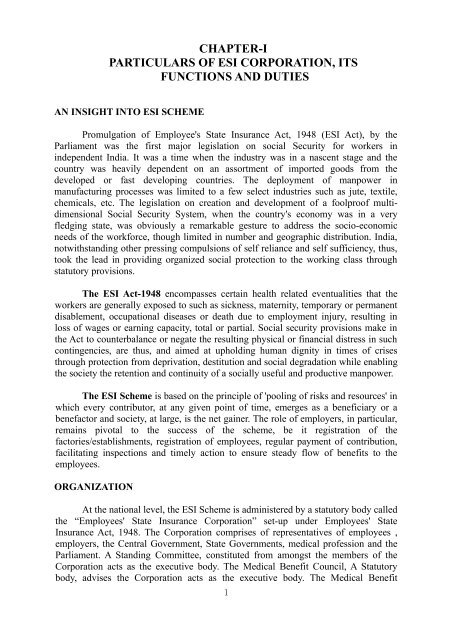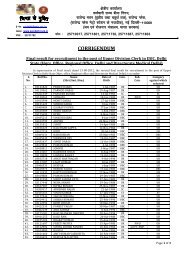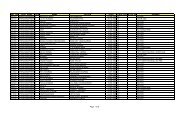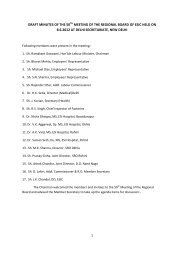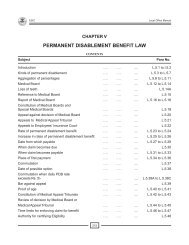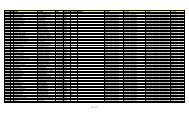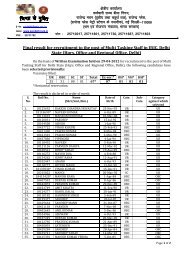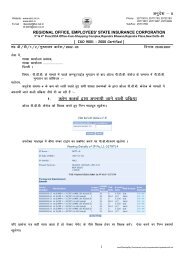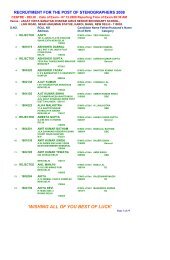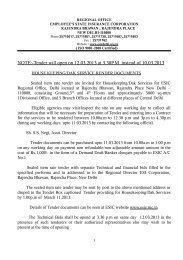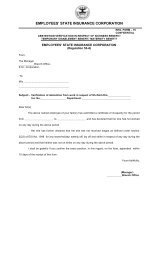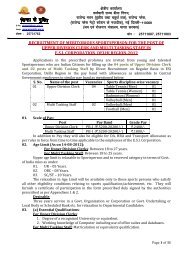right to information act - ESIC Delhi
right to information act - ESIC Delhi
right to information act - ESIC Delhi
Create successful ePaper yourself
Turn your PDF publications into a flip-book with our unique Google optimized e-Paper software.
Employees of the aforesaid fac<strong>to</strong>ries and establishments in receipt of wages notexceeding Rs.15,000/- per month (w.e.f. 01.05.2010) are covered under the Act.Disabled persons, working in fac<strong>to</strong>ries and establishments where ESI Act applies,drawing wages up <strong>to</strong> Rs.25,000/- per month are also coverable under ESI Act w.e.f.01.04.2008. About 3.94 Lakh fac<strong>to</strong>ries and establishment in 783 industrial centershave been brought under the coverage of the ESI Act benefitting about 1.43 Croreinsured persons and their Dependant family members.ESI MEDICAL SCHEMEMedical Care set upMedical care is provided through a network of ESI Hospitals, ESI Dispensariesand diagnostic centers as well as through tie-up arrangements with other medicalinstitutions. The medical care is, by and large, administered through the respectiveState Governments except in <strong>Delhi</strong> & Noida and Model Hospitals in each State whichare run directly by the corporation.Benefits and infrastructure for delivery of benefitsThe Scheme provides medical care and cash benefits in the contingencies ofsickness, maternity, disablement and death due <strong>to</strong> employment injury. Under thescheme medical care is also provided <strong>to</strong> families of the insured persons. Variousbenefits available are medical benefit, maternity benefit, sickness benefit, disablementbenefit (temporary & permanent), and Dependents benefit and funeral expenses.SYSTEM & LEVEL OF MEDICAL CARE SERVICESESI Scheme is providing medical care under different systems depending uponthe requirements of the region. The various systems prevalent are:-• Allopathy• Ayush which include Ayurveda, Sidha, Unani, Homeopathy and YogaESI Scheme provides all three different all three different levels of care i.e.Primary care, Secondary care and Teritary care (Super specialty care). Primary care isprovided through dispensaries & panel clinics. Secondary care is provided throughdiagnostic centers and hospitals. Tertiary care is provided by entering in<strong>to</strong> tie uparrangement with specialized private and government diagnostic facilities andhospitals,MEDICAL BENEFITS AVAILABLEESI scheme is providing full medical care <strong>to</strong> its beneficiaries which includepreventive, promotive, curative and rehabilitative services.3
PROVISION OF MEDICAL CAREMedical care services <strong>to</strong> beneficiaries are provided by <strong>to</strong>w ways:-• Direct Provision through ESI schemes own network of dispensaries, diagnosticcenters and hospitals.• Indirect Provision through tie-up with private clinics (panel system), diagnosticcenters and hospitals.DIRECT PROVISION ONThe direct system functions through a network of dispensaries (1402), ISMUnits (44), Hospitals (149), and annexes (42). As on 31.3.2010, the Corporation hascommissioned 23923 beds in 149 ESI hospitals, 849 beds in 42 Hospital annexes andreserved 2967 beds in other hospitals <strong>to</strong> provide indoor treatment (<strong>to</strong>tal 27739 beds).In addition medical care services are also provided through Mobile Dispensaries andEmployers utilization dispensaries. The services of mini dispensaries, mobiledispensaries and employer's utilization dispensaries are also utilized in places wherethe establishments of full time dispensaries are not justified/ possible due <strong>to</strong> variousreasons.INDIRECT PROVISIONA <strong>to</strong>tal of 1540 panel doc<strong>to</strong>rs are engaged in providing primary medicalservices through the indirect system. Under the panel system, the clinics of registeredmedical Pr<strong>act</strong>itioners are approved for providing outpatient care. There is prescribedprocedure <strong>to</strong> empanel such clinics. In establishing arrangements for outpatient care,due consideration is given <strong>to</strong> the distance <strong>to</strong> be covered, density of insurablepopulation etc. In addition the services not available in ESI hospitals and Diagnosticcenters and tertiary (super-specialty) medical care services are provided through tie upwith reputed private /govt. medical institutions.SCALE OF MEDICAL BENEFITFull Medical care is provided as per the need of the patient irrespective of theamount of contribution. In CGHS reimbursement & treatment is provided as percapping.MEDICAL BENEFITAs per the provision of Section 58 of the ESI Act, State Govt. is the designatedagency for delivery and administering medical care. Accordingly the medical careservices under ESI scheme in the states is provided by the respective StateGovernment except in <strong>Delhi</strong> and Noida where the medical care services are provideddirectly by ESI Corporation.4
SHARING OF MEDICAL CARE EXPENDITUREFor providing a uniform scale of medical care, the Corporation, as per theprovisions of Section 58(3) of the Act, enters in<strong>to</strong> an agreement with the StateGovernments. And the expenditure on medical care is reimbursed within theprescribed ceiling. The ceiling is revised from time <strong>to</strong> time which at present is Rs.1200/- per IP family unit per annum w.e.f. 1.4.2009. Out of this, Rs700/- is earmarkedfor administration and Rs. 500/- for other expenses (i,e, drugs and dressings, superspecialty etc.) In addition, there is a provision <strong>to</strong> reimburse <strong>act</strong>ual administrativeexpenditure <strong>to</strong> the State Governments on fulfillment of certain conditions. Besidesthis, an additional incentive of Rs. 50/- per I.P. Per family unit is being given <strong>to</strong> theState govt. on fulfilling stipulated terms and conditions for improvement of medicalscheme.5
In addition, ESI Corporation is incurring expenditure outside the ceiling fully and onshareable basis on various heads.NEW INITIATIVES BY <strong>ESIC</strong> FOR IMPROVING AND AUGMENTINGMEDICAL CARE SERVICESi) REMOVING DIFFICULTIES FACED IN FUNCTIONING DUE TODUALITY OF CONTROLESI Corporation has taken number of decisions for overcoming difficultiesbeing faced delivery of medical care services through ESI Hospitals and dispensariesdue <strong>to</strong> duality of control. The various <strong>act</strong>ions taken are:(a) REVOLVING FUND SCHEME: - To ensure supply of drugs anddressing and repair & maintenance of equipments, <strong>ESIC</strong> has set up revolvingfund with the consent of state government. Under this schemer the payment ismade by <strong>ESIC</strong> against the valid sanction of the state government out of themoney kept with the State Medical Commissioner office of ESI Corporation.(b) MODEL HOSPITAL SCHEME: ESI Corporation has taken a decision <strong>to</strong> setup one hospital in each State as Model Hospital. At present, <strong>ESIC</strong> has set upModel Hospital in 18 States (annexure). These hospitals are being up graded asper norms and standards laid down by ESI Corporation. The expenditure onModel Hospitals in fully born by ESI Corporation.(c) TAKING OVER OF ESI MEDICAL SCHEME IN THE STATES BY <strong>ESIC</strong>ORPORATION:- ESI Corporation has written <strong>to</strong> the State Govts. To givetheir consent for handing over the ESI Scheme <strong>to</strong> ESI Corporation. Four statesi.e. Madhya Pradesh, Himachal Pradesh, Bihar, Maharashtra and Meghalayashave given consent for handing over the scheme <strong>to</strong> ESI Corporation.ii)ZONAL SUPER SPECIALITY HOSPITALS:Four Super speciality hospitals have been proposed <strong>to</strong> be set up I four zones,i.e., south, East, West and North zone. In the first phase, super speciality hospital atSanath Nagar, Hyderabad for South Zone has been commissioned.Iii) CENTRAL RATE CONTRACT FOR ALLOPATHIC & AYURVEDICDRUGS:- To ensure uniformity in the supply of good quality drugs, <strong>ESIC</strong> isformulating Rate Contr<strong>act</strong> for drugs following bidding procedure and strict eligibilitycriteria's which is provided <strong>to</strong> the rates for adoption.iv) NORMS AND STANDARDS:- <strong>ESIC</strong> has formulated norms and standards forstaff and equipments for smooth of hospitals and dispensaries.6
v) DECENTRALIZATION:- Powers have been delegated <strong>to</strong> the State MedicalCommissioners for sanction of equipments, release of advance on accountpayments and repair & maintenance of equipments.vi)OCCUPATIONAL DISEASE CENTREESI Corporation has set up five occupational disease centre at Basaidarapur(New <strong>Delhi</strong>), Chennai (Tamilnadu), Kolkata(West Bengal), Mumbai(Maharshtra) and Indore (Madhya Pradesh) for prevention and early detectionand diagnosis of occupational diseases amongst ESI beneficiaries. Specialemphasis is being given for prevention of occupational diseases in insuredpersons working in hazardous industries.Vii)PREVENTIVE HEALTH SERVICESTo strengthen promotive and preventive health services under ESI medicalscheme, ESI Corporation has allocated a separate budget of Rs.20/- per IPfamily unit per annum. This will help in prevention of diseases like diabetes,hypertension, HIV/AIDS and also promote healthy life styles amongstbeneficiaries.Viii) EXPENDITURE N SUPER SPECIALTY TREATMENTTo provide cashless and hassle free medical services, ESI Corporation hastaken a decision for bearing the super specialty expenditure directly. For thistie up arrangements have been made directly by <strong>ESIC</strong> with reputed andGovt. /private hospitals for super specialty investigations and services.ix)IVF TREATMENTESI Corporation is providing artificial re-production and IVF treatmentfacilities <strong>to</strong> insured personsx) EXPANSION OF AYUSH FACILITIESESI Corporation is expanding provision of AYUSH facilities in ESI Hospitalsand dispensaries as per the local requirements of the area. For promoting thesame, the <strong>to</strong>tal expenditure on provision of AYUSH facilities I the first fiveyears is fully borne by ESI Corporation.xi) PATIENT SATISFACTION SURVEYESI Corporation has under taken patient satisf<strong>act</strong>ion survey in ESI Hospitals byindependent agencies and is taking various <strong>act</strong>ions based on the findings of thesurvey for improving the medical care facilities in ESI Hospitals.7
FINDINGS OF CLIENT SATISFACTION STUDY IN 21 <strong>ESIC</strong> RUN ESIHOSPITALS AND2-3 NEARBY ESI DISPENSARIES CARRID OUT BY THE INTERNATIONALINSTITUTE OF HEALTH MANAGEMENT RESEARCH, NEW DELHI IN 2008-09OPD:80% respondents use OPD facilities because of free treatment, medicines nearness,quality and availability of referral and infrastructure facilities. On an average about70% expressed satisf<strong>act</strong>ion with registration facilities, facilities in waiting areas,behavior of providers, support services and quality of care.IPD:81% of respondents use IPD facilities due free treatment, medicines, nearness,affordable cost and infrastructure facilities. 75% and above intended <strong>to</strong> use the <strong>ESIC</strong>Hospital services in future also due <strong>to</strong> available facilities, accessibility, quality of careand personnel relations/acquaintance with hospital staff.Dispensary Services:79% use dispensary facilities due <strong>to</strong> free treatment, nearness, good quality treatmentand affordable cost. 86% intended <strong>to</strong> use the same in future also.xii)GRADING AND ISO CERTIFICATION OF ESI HOSPITALS ANDDISPENSARIESESI Corporation is getting its hospitals and dispensaries graded by reputedorganizations. Further <strong>act</strong>ion has been initiated for getting ISO certification inrespect of hospitals and dispensaries.Xiii) STARTING OF MEDICAL EDUCATION INSTITUTIONAs a part of initiative for overcoming the shortage of medical manpower andimproving the services in ESI Hospitals, ESI Corporation has under taken aproject for starting medical colleges, nursing colleges, dental colleges andtraining school for other para medical staff in <strong>ESIC</strong>/ESI Hospitals. SixPGIMSRs have already started functioning in Kokata, <strong>Delhi</strong>, Mumbai (2)Chennai and Bangalore.xiv) CHANGE IN THE PATTERN OF REIMBURSEMENT OF MEDICALCARE EXPENDITURE TO THE STATES8
ESI Corporation has taken a decision <strong>to</strong> reimburse the administrativeexpenditure incurred by the State Govt on <strong>act</strong>ual basis without ceiling subject<strong>to</strong> fulfillment of certain conditions. This will ensure State Govts. To post themedical and para medical staff in ESI Hospitals and dispensaries as per normsand standards of ESI Corporation and will help in providing proper medicalcare facilities <strong>to</strong> ESI beneficiaries.xv)HOSPITAL DEVELOPMENT COMMITTEESHospital Development Committees have been constituted in all ESI Hospitalsand have been given adequate administrative and financial powers for takingdecisions for improvement in medical care facilities.xvi)MODERIZATION AND UPGRADATION OF INFRASTRUCTURE• It has been decided by the Corporation <strong>to</strong> modernaize/upgrade/expand all ESIhospitals in aphased manner and <strong>to</strong> bring them at par with privatecorporate hospitals. The bench mark fixed is that all treatment (includingdiagnostic) is make available <strong>to</strong> Insured Person in- house and he is referredoutside only as an exception.▪ Modernisation/upgradation/expansion of 29 ESI Hospitals at various locationsis underimplementation.xvii) HIV/AIDS PREVENTION & FAMILY WELFARE<strong>ESIC</strong> has undertaken a programme <strong>to</strong> strengthen the family welfare andIIV/AIDS control <strong>act</strong>ivities under project Sankalp in association with MS HLLLtd in the state of Karnataka and Uttar Pradesh.xviii) PROVISION OF PRIMARY AND SECONDARY CARE SERVICES BY<strong>ESIC</strong>DIRECTLYESI Corporation has decided <strong>to</strong> provide primary and secondary medical careservices in the areas directly where the concentration of Ips is more than 5000and there is no dispensary within 8 kms (5 kms in hilly areas) and whereconcentration of Ips is 25000 ( 15000 in hilly areas) and there is no hospital within25 kms. This facility will be available till the ESI establishes its own hospital anddispensary.xix) PROVISION OF SUPERSPECIALTY SERVICES FROM ANY OF THETIE UP HOSPITAL OF <strong>ESIC</strong> ANYWHERE IN THE COUNTRYPatients can avail super specialty treatment from any of the networked/tie uphospital of <strong>ESIC</strong> (7900) as per his choice anywhere in the country.9
xx) OPENING OF SURPLUS CAPACITY IN ESI HOSPITALS TO NON IPSON USER CHARGES.II.CASH BENEFITS(a)Sickness Benefit(Section-49 read with Rule-55 of ESI Central Rules):Sickness benefit is a periodical payment made <strong>to</strong> an I.P. For the period ofcertified sickness after completion of 9 months of Insurable Employment. A personshall be qualified <strong>to</strong> claim Sickness Benefit if contribution in respect of him waspaid/payable for not less than 78 days in the corresponding contribution period. It isnot paid for the first <strong>to</strong>w days of certified sickness. It can be availed formaximum of 91 days in any two consecutive benefit periods.After exhausting the Sickness Benefit payable up<strong>to</strong> 91 days, an I.P. If sufferingfrom T.B., Leprosy, mental or malignant diseases or any of the certified long termdiseases, is entitled <strong>to</strong> extended Sickness Benefit for a further period of 124 days/309days/730 days provided, he has been in conditions as per Corporation's resolution.(b)Enhanced Sickness BenefitThis benefit is payable <strong>to</strong> insured persons in the productive age-group forundergoing sterilization operation viz. Vasec<strong>to</strong>my/tubec<strong>to</strong>my. Duration ofenhanced Sickness Benefit is up<strong>to</strong> 7 days in the case of vasec<strong>to</strong>my and up<strong>to</strong> 14days in the case of tubec<strong>to</strong>my from the date of operation or from the date ofadmission in the hospital. Contribu<strong>to</strong>ry conditions for receiving the benefit aresame as normal Sickness Benefit.(c)Maternity Benefit(Section-49 of ESI Act read with Rule-56 of ESI Central Rules).Maternity Benefit is paid <strong>to</strong> an I.W. In case of confinement or miscarriage orSickness arising out of pregnancy. To be eligible for Maternity Benefitcontributions in respect of the I.W. Are payable/paid for not less than 70 daysin the immediately preceding two Contribution Periods. The benefit ispaid for a period of twelve weeks in case of confinement, six weeks in case ofmiscarriage or medical termination of pregnancy and for one additionalmonth in case of sickness arising out of confinement.10(d)
ConfinementExpenses:(Rule 56-A of ESI Central Rules).It is payable <strong>to</strong> an I.W. (or an I.P. In respect of his wife) provided that theconfinement occurs at a place where medical facilities under ESI Scheme are notavailable. A sum of Rs. 2,500/- per case is paid as confinement expenses for twoconfinements only.(e)Disablement Benefit:(Section 51 of ESI Act read with Rule 57 of ESI Central Rules)(i) Temporary Disablement Benefit:In case of Temporary Disability arising out of an Employment injury orOccupational Disease, Temporary Disablement Benefit is admissible <strong>to</strong> an I.P. Forthe entire period so certified by an IMO/IMP for which the I.P. Does not work forwages. This benefit is not subject <strong>to</strong> any Contribu<strong>to</strong>ry condition. Benefitshowever, are not payable if the incapacity lasts for less than 3 days excluding thedate of accident.(ii) Permanent Disablement Benefit:If an Employment Injury or Occupational Disease results in permanent, partial or<strong>to</strong>tal, loss of earing capacity of an employee, periodical payments are made <strong>to</strong> theI.P. For life at a rate, depending on the <strong>act</strong>ual loss of Earning Capacity as may bedetermined or certified by a duly constituted Medical Board. Rates of D.B. Aredetermined in accordance with Rule-57 of ESI Central Rules. The first payment ofPDB is required <strong>to</strong> be made within one month of submission of claim, complete inall respect.(f) Dependents' Benefit:(Section-52 read with Rule-58 of ESI Central Rule).Periodical payment is made <strong>to</strong> the Dependants of a deceased I.P. If the deathoccurred as a result of Employment Injury or Occupational Disease. Rate of11
Dependant's Benefit is aboutthe dependants in a fixed ratio.70% of the wages of the deceased, sharable by all(g)Funeral Expenses:(Section-46 (f) of ESI Act read with Rule 59 of ESI Central Rules).Funeral Expenses up<strong>to</strong> a maximum of Rs.10,000/- on the funeral of a deceasedI.P. Are reimbursed <strong>to</strong> the a est surviving member of the family or in his absence<strong>to</strong> the person who <strong>act</strong>ually incurs the expenditure on funeral.(h)Rajiv Gandhi Shramik Kalyan Yojna (RGSKY).Introduced w.e.f. 01.04.05, it seeks <strong>to</strong> provide succour <strong>to</strong> the workers coveredunder the scheme during period of involuntary unemployment. I.P's losingemployment due <strong>to</strong> closure of their fac<strong>to</strong>ry/establishment, retrenchement onpermanent disability due <strong>to</strong> non- employment injury ( at least 40% are entitled<strong>to</strong> unemployment allowance in cash, aswell as medical care for self and family for one year subject <strong>to</strong> the conditionthat the person was an employee on the date of loss of insurable employmentand should have contributed under the scheme for a minimum period of threeyears.Responsibilities of Employers• To apply in Form-01 for allotment of Code No. within 15 days of the <strong>act</strong>becoming applicable ` <strong>to</strong> the Fac<strong>to</strong>ry/Establishment.• To submit Declaration Forms in respect of all its employees coverable underESI <strong>act</strong>.• To ensure that all coverable employees present themselves with family in <strong>ESIC</strong>orporation for taking of pho<strong>to</strong>graph.• To maintain accident book and submit report of accident, if any, within 24hours of its occurrence <strong>to</strong> the Branch Office.•• To maintain records/registers as prescribed under ESI Act/Regulation.• To produce all records, as asked for, for Inspection/Test Inspection <strong>to</strong> SocialSecurity Officer/any other <strong>ESIC</strong> Officer.• To submit return with all columns filled, in accordance with Reg. 26 of ESI12
(Genl.)Regulation-1950.• To report promptly <strong>to</strong> concerned Regional Office/Branch Office of anyeventually such as closure of fac<strong>to</strong>ry/establishments, change in business<strong>act</strong>ivity, change of address, change of ownership of thefac<strong>to</strong>ry/establishment.Responsibilities of Employees(i) To submit correct <strong>information</strong> in respect of him/family in Declaration Form.(ii) Present himself/members of family for taking pho<strong>to</strong>graph.(iii)(iv)Preserve the Identity Card Properly.Should not receive any benefit improperly.13
Benefits Under ESI Act and Contribu<strong>to</strong>ry ConditionsNature ofBenefitsAvailable <strong>to</strong>1 Medical Benefits (a) To self andfamily of theemployee.(b) To self andspouse of retiredI”'s/I.ps who optedfor VRS or retiredprematurely afterrendering 10 yearsof service.Extent <strong>to</strong> whichavailableFull MedicalCare includingSuper SpecialityTreatmentFull MedicalCare2 Sickness Benefit Self 91 days in twoconsecutivebenefit periods3 Maternity Benefit Self 12 weeks in caseof confinementand 6 weeks formiscarriage/MTP4 DisablementBenefitEligibility ConditionsMedical Care is availableimmediately on joininginsurable employment. ForSuper-speciality treatmentthe I.P. Should be eligiblefor sickness Benefit.5 years for IP's retiring aftersuperannuation and 10 yearsin case of VRS etc.Contribution paid/payablefor 70 days in theimmediately preceding 2Consecutive Cont; Periodcorresponding <strong>to</strong> the benefitperiod in whichConfinement is expected <strong>to</strong>occur.Contribution paid/payablefor 70 days in theimmediately preceding 2Consecutive Cont. PeriodCorresponding <strong>to</strong> the benefitperiod in whichConfinement is expected <strong>to</strong>occur.14
(a) TemporaryDisablementBenefitSelfEntire period ofcertifieddisablement.Disablement should occurduring the course of and ou<strong>to</strong>f employment and I.P.Should not have worked forwages during the period.Nature of Benefits Available <strong>to</strong> Extent <strong>to</strong> whichavailable(b) Permanent Self For life at a ratedepending uponthe <strong>act</strong>ual loss ofearning capacityas may bedetermined by aduly constitutedMedical Board.5 Dependent Benefit Dependants of anI.P. Who has dieddue <strong>to</strong>EmploymentInjury6 Funeral Expenses Eldest servivingmember of thefamily or <strong>to</strong> theperson who<strong>act</strong>ually incurs theexpenditure.7 Rajiv GandhiShramik KalyanYojanaTo widow forlife or untilremarriage. ToDependantchildren up<strong>to</strong> theage of 25 years.Rs. 10,000/-(Lump-sum).EligibilityconditionsPermanent loss ofearning capacityshould occur due <strong>to</strong>Employment Injuryor due <strong>to</strong>occupationaldiseases.Death should occurdue <strong>to</strong> EmploymentInjury or occupationDiseases.No condition Paid inthe event of Death ofan I.P.Self One year Admissible <strong>to</strong> IP'swho becometemporarilyunemployed due <strong>to</strong>permanent closure ofa fac<strong>to</strong>ry or getsdisabled from nonemploymentinjuryafter rendering 3years of continuousservice.15
CHAPTER-IIPOWERS AND DUTIES OF THE OFFICERS ANDEMPLOYEES OF ESI CORPORATION'SDirec<strong>to</strong>r General, the Chief executive of ESI Corporation and the FinancialCommissioner are the principal officers of ESI Corporation who are appointed by theCentral Govt. in accordance with Section-16 of ESI Act-1948.Powers and Duties of the Direc<strong>to</strong>r General and the Financial commissioner aredetailed under Rule 16 & 19 of ESI Central Rules-1950 respectively which are asunder:1. Powers and duties of the Direc<strong>to</strong>r GeneralThe powers and duties of the Direc<strong>to</strong>r General shall be:-(i) <strong>to</strong> <strong>act</strong> as the Chief Executive Officer of the Corporation's(ii) <strong>to</strong> convene, under the orders of the Chairman, meetings of the Corporation, theStanding Committee and the Medical Benefit Council in accordance with the Act andthe Rules and <strong>to</strong> implement the decisions reached at the meetings.(iii)<strong>to</strong> enter in<strong>to</strong> contr<strong>act</strong>s on behalf of the corporation in accordance with the Act orthe Rules Regulations made thereunder, or the general or special instruction of theCorporation or the Standing Committee;(iv) <strong>to</strong> furnish all returns and documents required by the Act or the Rules <strong>to</strong> theCentral Govt. and <strong>to</strong> correspond with the Central Government and the StateGovernments upon all matters concerning the Corporation;(v) <strong>to</strong> furnish all returns and documents required by the Act or the Rules <strong>to</strong> theCentral Govt. and <strong>to</strong> correspond with the Central Government and the StateGovernments upon all matters concerning the Corporation;(vi) <strong>to</strong> undertake such other duties and <strong>to</strong> exercise such other powers as may from time<strong>to</strong> time, be entrusted or delegated <strong>to</strong> him.Direc<strong>to</strong>r General may, with the approval of the Standing committee, by general or16
special order, delegate any of his powers or duties under theRules or the Regulations or under any resolution of the Corporation or theStanding Committee, as the case may be, <strong>to</strong> any person subordinate <strong>to</strong> him. Theexercise or discharge of any of the powers or duties so delegated shall be subjected <strong>to</strong>such restrictions, limitations and conditions, if any, as the Direc<strong>to</strong>r General may, withthe approval of the Standing Committee, impose.2. Powers and duties of the Financial CommissionerThe powers and duties of the Financial Commissioner shall subject <strong>to</strong> the controlof the Direc<strong>to</strong>r General be:-(i) <strong>to</strong> maintain the accounts of the Corporation and <strong>to</strong> arrange for the compilationof accounts by(ii) <strong>to</strong> prepare the budget of the Corporation;(iii)(iv)the collection of returns from the Centres and Regions;<strong>to</strong> arrange for internal audit of the accounts of the Centres and Regionsand of the receipts and payments thereat;<strong>to</strong> make recommendations for the investment of the funds of theCorporation; and(v) <strong>to</strong> undertake such other duties and <strong>to</strong> exercise such other powers as may, fromtime <strong>to</strong> time, be entrusted or delegated <strong>to</strong> him.Powers and Duties of other senior officers of Hqrs. Office are available in thebooklet of “ESI Corporation-Rules of Business.” Similarly, powers & duties of theofficers of Field Offices are available in ESI Corporation combined booklet ofDelegation of Powers. The other senior officers and staff working in different officesof the Corporation provide necessary assistance for efficient trans<strong>act</strong>ion of business inrespective offices.17
CHAPTER-IIIPROCEDURE FOLLOWED IN THE DECISION MAKINGPROCESS INCLUDING CHANNELS OF SUPERVISIONAND ACCOUNTABILITYESI Corporation is a Statu<strong>to</strong>ry body, set-up by an <strong>act</strong> of parliament and functionsas per the provisions of the Act and Rules & Regulations framed by the CentralGovt./ESI Corporation as envisaged under the <strong>act</strong>.Any decision for amendment of ESI Act is taken by the Parliament.Further the Central govt. has been empowered <strong>to</strong> make rules in the mattersdetailed under Section-95(2) of ESI Act.Similarly, the Corporation has been authorised <strong>to</strong> make Regulations in the matterslaid down under Section-97(2) of ESI Act-1948.Consider with the decisions taken by the ESI Corporation and rules framed bythe Central Govt./Regulations framed by the Corporation, the <strong>ESIC</strong> Hqrs. Formulatespolicies for implementation by its various field offices.For functional convenience, Hqrs. Office has been divided in<strong>to</strong> followingdivisions:1) Insurance Division - headed by Insurance Commissioners2) Medical Division - headed by Medical Commissioner3) Administration Division - headed by Commissioner-(P&A)4) Finance Division - headed by Financial Commissioners5) Project management Division - headed by Chief engineer6) Vigilance Division - headed by Chief Vigilance Officer.7) Training Division - headed by Commissioner (NTA)Policy decisions taken at Hqrs. are communicated by respective divisions <strong>to</strong> thefield offices such as, Regional Offices, ESI Hospitals, ESI Scheme Direc<strong>to</strong>rates,SMCs Offices and branch Officers for effective implementation, as per powersdelegated <strong>to</strong> all Heads of Office level functionaries.18
CHAPTER-IVRULES REGULATIONS INSTRUCTIONS, MANUALS&RECORDS HELD BY <strong>ESIC</strong> OR USED BY ITSEMPLOYEES FOR DISCHARGE OF ITS FUNCTIONS_______________________________________________________________________________Sl. No. Name of the book_______________________________________________________________________________1.Employee State Insurance Act-1948(a) ESI (Central) Rules-1950.(b) ESI (General) Regulations-19502 Branch Office Manual (Procedures <strong>to</strong> be followed for payment etc.<strong>to</strong> thebeneficiaries in the Branch Offices).3 <strong>ESIC</strong> Medical Manual (Procedures <strong>to</strong> be followed by the IMOs forcertification and grant of medical benefit).4 Revenue Recovery Manual (Procedure of recovery of arrears ofrevenue).5 Manual of General Office Procedure (Procedures <strong>to</strong> be followed bytheofficers/officials of the <strong>ESIC</strong> in discharge of their officialfunctions.6 <strong>ESIC</strong> Manual of Audit & Accounts (General Rules and Principlesfollowed in Finance & A/cs. Div.)7 Record Retention Schedule (Reference book for <strong>ESIC</strong> Officesregardingretention period of various documents and records in<strong>ESIC</strong>)8 <strong>ESIC</strong> Construction Norms of Dispensaries and Diagnostic Centreetc. (Containsvarious details of area, electrical and sanitary fittingsetc. alongwith map of thetwo, three four & five doc<strong>to</strong>rs dispensariesand dispensary cum Diagnosticcentre).9 <strong>ESIC</strong> Staff ( Conditions of Service) Regulations 1959_______________________________________________________________________________19
CHAPTER-VSTATEMENT OF CATEGORIES OF DOCUMENTSIN <strong>ESIC</strong>Following categories of documents are held in various offices of <strong>ESIC</strong>.(A) ADMINISTRATIONAll Offices(a) personal records of officers and employees of the Corporation such asService Book of each employee, Service Card of all the officers, ConfidentialReports, Probation Progress Reports and personal files. Various Hypothecationdocuments for the loan and advances taken by the employees and officers. (Forexample, HBA. Mo<strong>to</strong>r Vehicle Advance etc.)(b) Seniority list(c) Recruitment Regulations.(d) D.P.C. Minutes.(e) Instructions on establishment matters.(f) Records involving recruitment of Staff and offices.(g) Record of all purchases made, Service and Maintenance of thefurniture/fixtures and equipments in the offices, dispensaries & hospitals of theESI Corporation.(B) REVENUE BRANCHES OF REGIONAL OFFICES(a) C-1 Register containing details of General and uncovered (marginal)Units.(b) SC-15 register containing details of inspections done.(c) Files of individual employer covered under ESI Act.(d) Prosecution Cases filed by the Corporation under Section 84 and 85 of ESIAct.(e) Cases filed by the Employers under Section 75 of ESI Act.(f) Medical Board Register.(g) Constitution of Medical Board.20
(h) Agenda and Minutes of Meetings of Regional Boards.(C) BRANCH OFFICES(a) Returns of Declaration Forms.(b) Declaration Form submitted in respect of each employee.(c) Live list of I.P.'s who are entitled <strong>to</strong> Medical Benefit.(d) Details of benefits availed by each employee from time <strong>to</strong> time.(e) All Regulation Certificates furnished by any I.P. for any benefit payment.(f) Accident reports and all corresponding papers.(g) Register for allotment of Insurance No.(h) R.C. Register.(D) FINANCE & ACCOUNTS DIVISION IN REGIONAL OFFICE.(i) Monthly Accounts.(ii) Receipt Book.(iii) Bank Scroll.(iv) Schedule Sheet.21
CHAPTER-VIARRANGEMENT FOR CONSULATATION WITH ORREPRESENTATION BY, MEMBERS OF PUBLIC FORPOLICY FORMULATION(1) At the Region level, Regional Boards are set up in each State or UT by theChairman, ESI Corporation in accordance with Reg. 10 of ESI (Gen)Regulations, 1950. Functions of Regional Board are set out in Reg.10 (14) ofthe said Regulations.(2) At Gross root level Local Committees are set up for such areas as may beconsidered appropriate by respective Regional Boards in accordance with Reg.10-A(1) of ESI (Gent.) Regs.-1950.22
CHAPTER-VIISTATEMENT OF BOARD, COUNSILS COMMITTEESAND OTHER BODIES(1) REGIONAL BOARDS(c)(a)(b)The Chairman, ESI Corporation constitutes a Regional Board for each State orUnion Terri<strong>to</strong>ry for performing functions as per Reg. 10(14) of ESI (Gent.)Regs. 1950.a Chairman nominated by the Chairman of the Corporation in consultation withthe State government or the Administration of the Union Terri<strong>to</strong>ry;a Vice-Chairman nominated by the Chairman of the Corporation inconsultation with the State government or the Administration of the UnionTerri<strong>to</strong>ry;one representative of the State or the Union Terri<strong>to</strong>ry nominated by the StateGovernment or the Administration of the Union Terri<strong>to</strong>ry;(d) (i) the Administrative Medical Officer or any other Officer directly incharge of the Employees' State Insurance Scheme in the State or the UnionTerri<strong>to</strong>ry-ex-officio;(ii)the SMC/SSMC of the Corporation-ex. Officio.(e) one representative each of the employers and employees from the State or theUnion Terri<strong>to</strong>ry nominated by the Chairman of the Corporation in consultation withsuch organisation of the employers and the employees as may be recommended forthe purpose by the State Government or the Union Terri<strong>to</strong>ry;(f) members of the Corporation other than the Chairman and the Vice Chairmanand officials, if any, amongst those nominated by the Central Governmentunder clause © of section 4 of the Act, residing in the State or the Union Terri<strong>to</strong>ryexofficio;(g) members of the Medical Benefit Council nominated by the CentralGovernment under clauses (e) , (f) and (g) of Section 10 of the Act, residing in theState or the Union Terri<strong>to</strong>ry- ex-Officio.Provided that where the Chairman of the Corporation so considers it <strong>to</strong> beexpedient, he may nominate such additional representatives of employers andemployees, not exceeding three from each side with a view <strong>to</strong> providing for theadequate representation of important organisations not included in the nominationsof the State government or the Union Terri<strong>to</strong>ry, and <strong>to</strong> maintaining the parity betweenthe number or representatives of such employers and employees.Provided further that the Chairman of the corporation shall nominate such additionalrepresentatives of employers and employees not exceeding three from each side wherethe number of representatives of employers and employees including the ex-officiomembers is less than three each.23
Working of Branches in Regional Office <strong>Delhi</strong> BranchesCash Branch1. Pay Bill – Officers, SSO, UDC2. Medical Bill3. Tuition Fee4. GPF5. TA6. Honorarium7. Leave Encashment8. Income Tax Calculation9. Other Arrear Bill10.Third Party Bill11.Advance Payment12.Adjustment of Advance Budget13.TDS Bill / Certificate14.Telephone BillInsurance Branches1. Deal with employers file2. Collect the revenue from the defaulter employerCo-ordination Branch1. All <strong>ESIC</strong> – 92. Summons Works3. Branch wise distribution of Dak received from SSO4. SSO meeting Work5. Hold O & M MeetingPG Cell1. Deal with complaint received from complainant24
jktHkk’kk “kk[kk1- foHkkxh; jktHkk’kk dk;kZUo;u lfefr dh cSBdksa dk vk;kstu2- jktHkk’kk laca/kh fujh{k.k @ laidZ djuk3- fganh i[kokM+k @ fnol rFkk fofHkUu izksRlkgu ;kstuk,a4- dk;Z”kkyk5- iqLrdksa dh [kjhn rFkk iqLrdky; dk j[kj[kko6- okf’kZd dk;ZØe7- ekfld @ frekgh @ okf’kZd fjiksVZ eq[;ky; Hkstuk8- okf’kZd fVIi.k vkys[ku izfr;ksfxrk9- uxj jktHkk’kk dk;kZUo;u lfefr10- lalnh; jktHkk’kk lfefr11- eq[;ky; ls izkIr vuqns”k12- vuqokn dk;Z ,oa vuqokn izf”k{k.k13- dk;kZy; dks vf/klwfpr djokuk14- x`g if=dk dk izdk”ku15- “kk[kkvksa dks fofufnZ’V djokuk16- Tkap fcanqvksa dk vuqikyu17- jktHkk’kk vf?kdkfj;ksa dk lEesyu laca/kh i=kpkj18- {ks=h; dk;kZy; dh lHkh “kk[kkvksa @“kkñdkñ@izñdkñ ls fjiksVZ izkIr djuk rFkk mudh leh{kkdjuk19- le; ikcanh fjiksVZ20- vuqifLFkfr fjiksVZ21- vkdfLed @ vftZr vodk”k25
22- fofHkUu “kk[kkvksa ls izkIr ifji=23- fganh iz;ksx izksRlkgu izfr;ksfxrk24- Jqrys[k izfr;ksfxrk25- fganh Vad.k @ vk”kqafyfi izf”k{k.k26- fganh izcks/k] izoh.k] izkK izf”k{k.k27- “khYM @ py “khYM laca/kh i=kpkj28- izf”k{k.k laca/kh jksLVj rS;kj djuk29- O;fDr”k% vkns”k tkjh djuk30- xkMZ Qkbyksa dk j[kj[kko31- fofHkUu “kk[kkvksa ls izkIr Vad.k dk;Z32- jktHkk’kk “kk[kk dk Vad.k dk;Z33- “kk[kk dk Mk;jh @ fMLiSp34- vukifRr izek.k i= tkjh djukLegal Branch1. Deal with All Court Cases2. Summon / Warrant / Notice workBenefit Branch1. Death Cases & DB Cases2. Super specialty3. Entitlement4. Legal Cases5. RTI Cases6. Accident Cases7. Rajiv Gandhi Yojna8. Other Allied and related matter9. Audit / Inspection of Branch Offices10.Complaint11.Times Barred Cases12.Sickness Benefit Cases26
13. 2 nd Spell Cases14.Funeral Cases15.Maternity Cases16.ESB17.60/61 Cases18.Medical Board Cases19.All Statement20.Commutation Cases21.Budget22.AE CasesEDP & Survey Branch1. Departmental Test / Typing Test2. System / Technical issues in RO / BO3. Training Work at RO4. Support the employers and IPs5. Allotment of Sub-Code <strong>to</strong> employer6. Issue of Password <strong>to</strong> employer7. Deletion of MC & Challans on request by employer8. Update Name, Address of the employer9. New Registration10.Put up Third Party BillRecovery Branch1. Recovery from DefaulterBIFR Branch1. All correspondence <strong>information</strong> & dealing work with other states (except<strong>Delhi</strong>)Dispatch Branch1. All types of Dak received and distribute the dak <strong>to</strong> respective branches.2. All types of DispatchAdministration Branch27
1. Recruitment and Appointment of LDC/Steno/Peon.2. Appointment on Compassionate Ground.3. Appointment of Meri<strong>to</strong>rious sportsperson.4. Ad-hoc Promotion <strong>to</strong> the post of I.I./Asstt./UDC/LDC/R.S.5. Holding of DPC for promotion <strong>to</strong> the post of Asstt./UDC/LDC/R.S.6. Screening for Conversion from Sweeper/Farash.7. Transfer/Posting of all cadres.8. Reallocation of work of Officers.9. Creation/Surrender of posts.10.ACP Promotion/Up-gradation.11.Service Book Entries (regarding subjects allotted)12.ERP related work relating <strong>to</strong> Mapping etc.13.Matters relating <strong>to</strong> SC/ST Associations/Union (Staff)/<strong>ESIC</strong> OfficersAssociation and grant of Special Casual Leaves.14.PLB.15.Regional Board Work/SC/Corporation Meeting Work.16.Group Saving linked Insurance Scheme.17.Delegation of Powers.18.Working of Region (Note).19.Audit (Internal/External).20.All type of cases of TA/DA/Tour Programme.21.Increment & Pay Fixation in respect of LDC, UDC & Assistant cadre.22.Service Book Movement.23.Work related <strong>to</strong> G.P.F.24.Conveyance / Computer Advance/Festival.25.Leave Encashment in respect of working employees.26.Cash handling Allowance.27.Half Yearly Inspection of Branches.28.Family Planning Allowance / Special CL on account of Family Planning29.Statements (MP/MLA/VIP Letters Training)30.Forwarding of Application <strong>to</strong> other Department.31.Reimbursement of Tuition Fees.32.Festival Advance.33.Observation of Anti Terrorism Day/Sadbhawna Diwas/Quemi Ekta Week.34.All Type of NOC (NOC for Passport, NOC for further employment, etc.)35.Reservation of TOR/Camp Accommodation/Holiday Home.36.Attend service matter cases in High Court/CAT/Labour Court/Deputationfor witness of staff in Court Cases.37.Holding of DPC under FR 56(J).38.Preparation of Pension cases.39.Resignation / Voluntary Retirement40.All type of leave (EL, ML and CL/RH).41.Absentee Statement.42.Punctuality.28
43.CL/RH records of Officers/B.M.s/Officials of Branch.44.Service Book Entries (regarding subjects allotted)45.All type of Training.46.Departmental Test/ Typing Test (Quarterly/Half Yearly) & Exemptionfrom passing Typing Test.47.Permission under Rule 18 (2) & (3) of CCS Conduct Rules, 1964.48.Preparation of Roster.SC/ST Statements.49.Work related <strong>to</strong> TA Bill50.LTC/Home Town.51.Service Book (Verification char<strong>act</strong>er, educational qualification,nomination, addition, exp. certificate, permission for further studies).52.Verification of Veracity of Caste Certificate/Education QualificationCertificate.53. Service verification and Issuance of ‘Completion of 25 Years of Service’Certificate.54.Sports related <strong>act</strong>ivities.55.Preparation of Seniority List.56.I.S.O.57.Increment & Pay Fixation in respect of I.I. cadre.58.SBF59.Work related <strong>to</strong> Contr<strong>act</strong>ual Staff60.M.P.R./Weekly/Monthly/Quarterly/Half yearly summary.61.Receiving of Daily Attendance Report/Register.62.Hindi correspondence work/Hindi statement.63.Addresses of staff and officers.64.Increment & Pay Fixation in respect of Group ‘D’ cadre.VIGILANCE CELL1. Vigilance and all related works.2. Disciplinary work.3. Vigilance Cases.4. Issue of Identity Card.5. Subletting of Staff Quarter.6. Complaints having vigilance angle against staff.7. Attachment of Salary related works.8. Service Book Entries (regarding subjects allotted)9. Women Cell.10.Complaints related <strong>to</strong> Insurance Division received directly or throughHqrs. Office (vig.) and JD(Vig.) (NZ) and follow up of report.11.Annual Immovable Property Return.12.Confirmation.13.H.B.A.29
14.Inspection of Local Offices by Vigilance Inspection Unit/Serious Audi<strong>to</strong>bjections.15.A.C.R.16.Probation period.17.Service Book Entries (regarding subjects allotted)Accounts Branch1. Salary Bill2. Pay Fixation of Officers3. GPF Advance / Withdraw4. Leave Encashment5. Leave records of Officers6. All type of concurrence7. Monthly accounts statements8. PLB Statements9. DO <strong>to</strong> DG10.Budget11.DCR12.Medical Reimbursement13.Tution Fee14.Salary Bills15.Audit16.Pension Files17.Challan posting checking18.ECS19.Verification of Credit30


